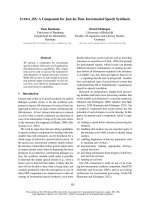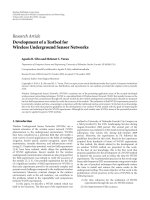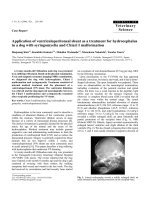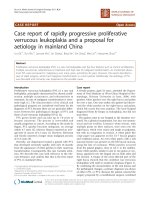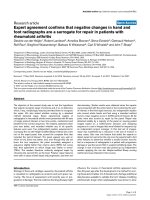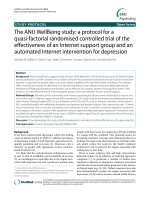action research through lesson study a space for learning in initial teacher training
Bạn đang xem bản rút gọn của tài liệu. Xem và tải ngay bản đầy đủ của tài liệu tại đây (631.62 KB, 19 trang )
<span class="text_page_counter">Trang 1</span><div class="page_container" data-page="1">
<small>Full Terms & Conditions of access and use can be found at</small>
<b>Educational Action Research</b>
<b>Connecting Research and Practice for Professionals and Communities</b>
<b><small>ISSN: (Print) (Online) Journal homepage: www.tandfonline.com/journals/reac20</small></b>
<b>Action research through lesson study: a space forlearning in initial teacher training</b>
<b>Laura Pérez Granados, Noelia Alcaraz-Salarirche, Manuel Fernández Navas& Ana Yara Postigo Fuentes</b>
<b>To cite this article: Laura Pérez Granados, Noelia Alcaraz-Salarirche, Manuel Fernández</b>
Navas & Ana Yara Postigo Fuentes (2024) Action research through lesson study: a spacefor learning in initial teacher training, Educational Action Research, 32:1, 7-24, DOI:10.1080/09650792.2022.2108473
<b>To link to this article: online: 08 Aug 2022.</small>
<small>Submit your article to this journal </small>
<small>Article views: 361</small>
<small>View related articles </small>
<small>View Crossmark data</small>
<small>Citing articles: 1 View citing articles </small>
</div><span class="text_page_counter">Trang 2</span><div class="page_container" data-page="2"><b>Action research through lesson study: a space for learning in initial teacher training</b>
Laura Pérez Granados<small>a</small>, Noelia Alcaraz-Salarirche<small>a</small>, Manuel Fernández Navas<small>a </small>and Ana Yara Postigo Fuentes<small>b</small>
<small>aDepartment of Didactics and School Organisation, School of Education Sciences, Málaga University, Málaga, Spain; bDepartment of Translation and Interpretation, School of Philosophy and Letters, Málaga University, Málaga, Spain</small>
<small>The purpose of this paper is to explore the influence of Lesson Study on reconstructing students’ practical knowledge during initial training as prospecting teachers. This case study sets out the voice and opinions of a student taking part in a lesson study process. The aim was to further understand how the student’s opinions around teaching change both during and after her invol-vement in the different phases of Lesson Study. Information was obtained through semi-structured interviews, observations, photo and video records, document analysis and field diaries. We were also interested in understanding the student’s perception of the influence of mentoring and tutoring on her professional develop-ment while accompanying her in her reflection about teaching. The results show that Lesson Study, as a cooperative curriculum crea-tion process, provides prospecting teachers with opportunities to build their identity as professionals within a network of peers in which they interact in order to learn together. Focused on the context of initial teacher training, this article could lead to a new approach to Lesson Study as a strategy that can bring about more relevant transformations while teachers’ beliefs, values and disposi-tions are still at an early stage of construction.</small>
<b><small>ARTICLE HISTORY </small></b>
<small>Received 10 August 2021 Accepted 29 May 2022 </small>
<b><small>KEYWORDS </small></b>
<small>Lesson study; practical knowledge; tacit knowledge; pre-service teacher training; academic and professional practice; final degree project</small>
<b>1. Introduction</b>
<i>This study is part of a research project entitled ‘Lesson Studies, School and University: Researching the Reconstruction of Practical Knowledge in Initial Teacher Training [Lesson Studies, Escuela y Universidad: Investigando la reconstrucción del conocimiento práctico en la formación inicial del profesorado]’ and was supported by supported by the Ministry of </i>
Economy, Industry and Competitiveness of Spain, within the framework of the National Project of I + D under Grant (EDU2017-86,082-P). The main purpose of this project is to further understanding of knowledge and practical thinking around teaching, along with its dimensions, pedagogical attributes and possibilities for transformation, with a view to improving initial teacher training. The main focus of the research is the development of the collaborative action research modality known as Lesson Study. A range of case studies
<b><small>CONTACT </small></b><small>Laura Pérez Granados </small>
<small> class="text_page_counter">Trang 3</span><div class="page_container" data-page="3">
and multi-case studies is used to investigate its implementation in initial training in academic subjects and courses where it is part of teaching practice, together with an analysis of how its development affects practical knowledge reconstruction processes among prospective teachers.
In particular, the case study developed here focuses on understanding the practical knowledge reconstruction process of a student on the Early Childhood Education degree course, who is taking part in a lesson study experience in the subjects Academic and Professional Practice III and Final Degree Project (FDP) at the Faculty of Education Sciences at the University of Malaga, Spain. Specifically, our goal was to better understand the keys to the transformations in her practical knowledge through her participation in the different phases of the lesson study. We also studied the impact of the teacher’s mentoring/tutoring on the student’s dispositions, knowledge and skills. The study is motivated by the need to analyse new training processes that move away from the traditional academic approach by researching and developing content and processes for training that are more closely linked to the dimensions and attributes of practical knowledge, to its construction processes, and to its possibilities for analysis, reflection and reconstruction.
<b>2. Rethinking teaching: from Action Research to Lesson Study in initial training</b>
Lesson Study as a strategy for improving teachers’ teaching and learning, originated in Japan in the 1990s and has gradually been adopted in Asia, the USA, Canada and Europe (Fernández 2005). It refers to the process of work and inquiry that groups of four to six teachers develop to work on the design, development, testing, critique and improvement of an experimental didactic proposal (lesson) (Pérez Gómez and Soto 2011). According to Lewis (2002), Lesson Study is a system of teacher learning, a set of practices, habits of mind, interpersonal relationships, structures, and tools that help teachers to work colla-boratively and improve their practice. It is therefore, a process in line with action research: action for change and research for understanding.
Because of the need to legitimise Lesson Study as a research process scientifically (Stylianou and Zembylas (2019), Takahashi and McDougal 2016 later defined it as a strategy with a clear research purpose, which includes the design of a lesson, and which involves the discussion and sharing of results about it. As Rué (2016) suggests, Lesson Study has incorporated new nuances, knowledge, and criteria that appeal to the professional, linking meaning and system; it is thus proposed as a means to improve learning and, therefore, teaching (Dudley 2015). This updated dimension of Lesson Study can be con-sidered as processes of experimentation and inquiry into pedagogical knowledge. As Elliott (2015) points out, the knowledge produced in the process of experimentation has a singular character, which prevents its generalisation, although, in the design and assessment phases, teachers use their own, or other people’s, theoretical pedagogical concepts to interpret the concrete evidence that contributes to reconstructing their practical knowledge.
Lesson Study could also be understood as a concrete form of Cooperative Action Research specifically designed to improve teaching (action) through research and teacher education. In our understanding, and as we can see from the results of the present study, one of the most outstanding aspects of Lesson Study as Action Research lies in the collaboration, the balance, between research and action, and the prioritisation of future
</div><span class="text_page_counter">Trang 4</span><div class="page_container" data-page="4">professional learning. Action Research and Lesson Study therefore share a number of common features that illustrate processes of reform and change linked to educational practice. For example, both include systematic cycles of planning, action, observation and reflection (Kemmis and McTaggart 2000). However, Elliott (2019) assumes that Lesson Study contains a cycle of enhanced repetition with the aim of improving the quality of instructional design. Nevertheless, the boundaries between the two are currently very blurred, with some authors describing them as one part or form of another. In this sense, Dudley (2014) states that Lesson Study is a specific form of classroom action research that focuses on developing knowledge of teaching practice.
Lesson Study as an action research process includes the following steps (Pérez Gómez and Soto Gómez, 2011):
(1) Define the problem.
(2) Cooperatively design an experimental lesson and the process of observing it.(3) Teach and observe the development of the proposal.
(4) Collect evidence and discuss its significance.(5) Analyse and revise the proposal.
(6) Develop the revised project in another classroom by another teacher and observe again.
(7) Discuss, evaluate and reflect on the new evidence and disseminate the experience in a wider context.
This fits with the vision of professional development and action research advocated by Stenhouse (1975), which focuses on a spiral process that generates change through reflection.
<i><b>2.1 From Practical Knowledge to Practical Thinking through Lesson Study</b></i>
Developing a lesson study process means embarking on a journey that engages the essence of the teacher, their values, beliefs, and emotions, as well as their knowledge, skills and attitudes (Soto et al. 2019). The key step introduced by Korthagen (2010), building on Schön’s (1987) thinking, and which our research group has been developing, expanding and structuring with a lesson study proposal, is the convergence of two
<i>complementary processes that must necessarily be present in teacher training: tion of practice and experimentation of the theory (Soto, Serván, and Pérez Gómez </i>2015). The theorisation of practice (Hagger and Hazel, 2006.) is the process in which teachers identify, review, question and recreate the images, ideas and practices they develop in their daily lives. The experimention of the theory is the process of translating the reformulated personal theory and reflection on our practice into new schemas and operational habits that build on our newly informed Gestalt to govern practice (Korthagen 2010).
theorisa-In relation to initial teacher education models, Farrell (2006) argues that these should evolve towards less technical approaches to focus more on teaching what it means to be a teacher. Lesson Study distinguishes itself from other training strategies by focusing on collective rather than individual work (Stigler and Hiebert 1999; Stepanek et al. 2007). Among the emerging contributions on this subject that underpin our research, it is worth
</div><span class="text_page_counter">Trang 5</span><div class="page_container" data-page="5">highlighting the work of Rodríguez and Fitzpatrick (2014) on the need to broaden the focus of inquiry in the field of initial teacher training, bearing in mind that teachers’ practical thinking (Schön 1998) is not directly related to their academic knowledge, and, therefore, it is necessary to undertake training processes that connect theory and practice so that future teachers are able to make decisions within the complexity and uniqueness of practice. In this sense, we look at the lesson study as a strategy that creates spaces and facilitates and stimulates the trainee teacher to develop as an autonomous professional capable of designing and planning teaching in a reflective way, and seeking the inter-relation between theory and practice.
<b>3. Methodology</b>
This study falls within the framework of qualitative research, the purpose of which is ‘to understand experience as closely as possible to how its participants feel or experience it’ (Sherman and Webb 1988, 7). This case study is also part of a sample consisting of eight studies, comprising a total of 50 students from the Bachelor’s Degrees in Early Childhood Education, Primary Education and Pedagogy and eight tutors from the same degrees who act as lesson study advisors. It seeks to understand, in depth, the key points of the case study in order to promote transferability to other contexts, since qualitative research focuses on internal rather than external generalisation as a way to foster transferability (Maxwell 2020; Fernández Navas et al. 2020).
<i><b>3.1. Focus and aims</b></i>
This study aims to explore the different possibilities offered by Lesson Study to question beliefs, attitudes and values around teaching prospective teachers in relation to tutored curriculum creation processes. It focuses on Estrella, a 22-year-old student who is cur-rently in the final year of an Early Childhood Education Degree at the University of Malaga. Specifically, the research aims to answer the following questions:
(1) Is Lesson Study a methodological strategy that allows Estrella to establish bridges between theory and practice when designing, developing and experimenting with educational activities?
(2) Does the lesson study allow Estrella to improve her formative processes in the design of the experimental lesson?
(3) Does Lesson Study help to promote the reconstruction of Estrella’s practical edge in her initial teacher training?
<i><b>knowl-3.2. About the participants</b></i>
As Estrella reveals in the interviews, she is a hard-working, committed student who acknowledges some difficulty in managing uncertainty. She declares herself very family focused, and, when faced with situations she does not know how to respond to, she asks for advice from her parents, who provide her with emotional and professional support. She is a cheerful, friendly person with an excellent predisposition to collaborate in
</div><span class="text_page_counter">Trang 6</span><div class="page_container" data-page="6">whatever she is asked to do. She is very expressive in her explanations and addresses all important aspects clearly, thus making reflection and inquiry around her school back-ground much easier.
Adela is a non-tenured lecturer with 12 years’ experience in university teaching, the last four in this university faculty. Committed to her profession, she shows enduring interest in helping her prospective teachers and is also observant, reflective and a good listener. These attributes, according to Stenhouse (1998), bring her closer to the model of a teacher who researches his or her own practice in order to change, modify and improve it. She is a generous, approachable person who is very confident in her professional decisions and knows how to earn the respect of her students through the relationship she builds with them based on transparency and trust. In the informal conversations held with her, she says that she is a professional who is consistent in her pedagogical convictions, which she has been building throughout her training and which guide her didactic decisions and her actions with her students.
<i><b>3.3. Sample and research instruments</b></i>
The research was conducted at the Faculty of Education Sciences at the University of Malaga during the academic year 2018/2019. Specifically, the study focuses on Estrella, a student enrolled in the Practicum III and Final Dissertation (FD) modules as part of the Degree in Early Childhood Education. It also concentrates on the teacher, Adela, who had accompanied and tutored this student since Practicum I. Estrella designs, develops, and tests a lesson study cycle with an experimental lesson and an improved lesson alongside a group of five other students. It is this lesson study process that is described in this paper, a lesson study undertaken by teacher education students within their teaching practice.
The lesson design was aimed at a group of 24 children aged 3 and 4 years old, who were part of an early childhood classroom in a public school in a small town near Malaga. The focus of the didactic design was on psychomotor skills, since, during the observation period, our prospective teacher observed that the methodology used in the classroom forces the children to remain seated for most of the school day, so the group agreed to focus their intervention on psychomotor skills sessions.
The data for this research were collected over an 8-month period using semi-structured interviews, informal conversations, observations, and document analysis. Table 1 shows the research process over time, as well as the different information collection strategies employed.
During this period of time, and in order to provide us with a detailed, rich and triangulated understanding of the possibilities for transformation of the student’s sub-jective dispositions and the impact of the tutoring teacher’s practical knowledge on them, we used the following data collection strategies:
<b>- Semi-structured group and individual interviews. There were two individual </b>
inter-views with Estrella, one at the beginning of Practicum III and the other after the tion of her Autonomous Intervention Project<sup>1 </sup>at the end of her practicum period. There was also one group interview with all the students involved in the design of the lesson study. The interviews were transcribed and categorised (Flick 2007; Maxwell 2012) for the analysis and triangulation of information (Gibbs 2012; Simons 2011).
</div><span class="text_page_counter">Trang 7</span><div class="page_container" data-page="7"><b>elabora-- Researcher’s diary. These personal notes on the study progress have been </b>
a constant support that have enriched and reoriented the development of the research and the subsequent analysis of the information gathered.
<b>- Observations. The observation records were carried out in two work seminars on </b>
Practicum III and also during the experimentation of the lesson that Estrella developed. These observations were the main source of data to understand the changes in the student as she participated in the lesson study. It also helped us to contrast, first-hand, the tutor’s practical knowledge with the information obtained in the interviews and the way Estrella acted in relation to the Lesson group and the tutor, and to capture the dimensions of the student’s practical knowledge.
<b>- Document analysis: We had access to Estrella’s diaries and portfolios from Practicum </b>
I to Practicum III and to her improved Final Degree Project design, which provided an excellent opportunity to see how she has evolved from the beginning to the end of her training as a teacher.
<b>- Informal conversations with the tutor. Informal conversations with the tutor </b>
during the fieldwork provided the opportunity to enrich the data. Hammersley and Atkinson 2007. argue that these conversations often produce more authentic data when the dialogue takes place in a more everyday context in a more natural and less artificial way. In this sense, it has provided us with very valuable information regarding Adela’s understanding of the teaching-learning process, the reasons that led her to make certain decisions when organising seminars, providing materials, managing time, etc., in short, the way she accompanies the learning process of her students.
<b>4. Results and discussion</b>
Below we briefly present a synthesis of the findings in relation to the three main lines of inquiry in order to understand how a trainee teacher experiences the learning process when taking part in the lesson study methodology. These lines refer mainly to changes in Estrella’s pre-existing attitudes and beliefs, how her participation in the lesson study challenged them, and the changes in knowledge and understanding which arose as a result.
<b>Table 1. </b>Summary of the research framework.
<small>- Group interview - Individual interview - Informal conversations - Observation in seminars and </small>
<small>in the experimental lesson - Researcher’s diary</small>
<small>- Interview transcription - Initial reading of all </small>
<small>the information - Return of the </small>
<small>transcripts to the protagonists</small>
<small>- Emerging categories </small>
<small>- Identification of extracts for the construction of evidences - Creation of categories - Report writing - Return of the Report </small>
<small>- Incorporation of the assessment of the participants on the initial report</small>
<small>October 2018November 2018 to June 2019 October 2019 to August 2020</small>
</div><span class="text_page_counter">Trang 8</span><div class="page_container" data-page="8">In accordance with the case study methodology used for the research, the results and their discussion are presented together. We would understand that there are no ‘pure’ results, but that they always depend on the context as well as being related to it. This is what Flyvbjerg (2006) explains when he speaks of the broad possibilities of case studies for the generation of situated knowledge. This explains the linking of the results to their discussion, since without the integration of both sections we would have sacrificed part of the overall understanding of the study.
<i><b>4.2. Changes in attitudes and beliefs</b></i>
Estrella described herself as having been a dedicated, consistent child who devoted many hours to studying and homework. As a consequence of the time she spent memorising content, Estrella developed great capacity to mechanically and superficially reproduce and repeat data. This is a form of lower-order knowledge (Pérez Gómez 2012) that is rewarded in traditional schooling, which relates academic success to obtaining good grades. As Estrella put it:
<small>I studied by learning by heart, which I found tough, although if you spend enough time on it, then it is impossible not to get an “A”. (Individual Interview, 19/02/2019)</small>
These study routines and the type of teaching model she received during her time in the education system promoted in her, possibly unconsciously, a passive attitude towards learning and a lack of critical attitude.
In this sense, some authors (Beard and Hartley 1984; Brown and Atkins 1988) point to the fact that certain methodological strategies, as well as the teacher-centred unidirec-tional model, may, despite widespread use, lead to limited critical and creative thinking among pupils. It is sad that, when asked how she would define her time at school, she said ‘Tell me what to do and I’ll do it’, given that in her account she insisted that she faced enormous difficulties in progressing in those subjects which involved higher order skills and abilities, such as arguing, creating and transferring (Pérez Granados 2014) and was unable to adapt to the teaching methodology.
In her statements, she explicitly praised teachers who followed models which, ing to the categorisation made by Trillo (1996), were closer to the profile of technical professionals, while at the same time she judged and questioned teachers who carried out more active, pupil-centred methodologies. This vision of teaching was strongly conditioned by the models of teachers she had as references, and, when asked whether school prepared her for life, she said that she did not retain any learning that could be considered valid in her day-to-day life:
<small>accord-Learning by heart has not really helped me at all [. . .] There are people who learn by heart, and maybe it stays with them, but not me . . . If you ask me two days later, then I don’t remember it any more. (Individual Interview, 19/02/2019)</small>
She admitted that the most positive aspect was to have managed to get to university and recognised that this merit was achieved thanks to her effort in studying steadily and with the idea of obtaining the best grades. This demonstrated the important role played by her beliefs in terms of what she considered academic success to be.
</div><span class="text_page_counter">Trang 9</span><div class="page_container" data-page="9">Estrella acknowledged that, when she arrived at university, the stifling teaching model she had received previously did nothing to help her adapt to this new stage. However, it seemed that she was gradually able to recognise and become more critical of the teaching received. In contrast to her beliefs about the traditional role of the teacher and transmitting content, she stressed the need to develop a pedagogy based on inquiry and construction that would allow the transformation of individuals (Carr and Kemmis 1986).
This change in discourse after having participated in the lesson study process possibly offered a first glimpse of nuances in the reconstruction of how she conceived the teaching profession and her didactic knowledge, consciously ques-tioning the teaching model received. However, when analysing her diaries, we found some elements that showed certain discrepancies between what she said the work of an early childhood teacher should be and her beliefs about what it is to be a teacher, i.e. between her espoused theories and her theories-in-use.
When talking to Estrella about the teaching role and the positive and negative traits she highlighted in the teachers she had throughout her school years, she instantly recalled those who made her feel confident in the subject and stated that teachers should be evaluated according to the effects they produce on the pupil, largely conditioned by their personal attributes. She therefore demonstrated once again how her beliefs were anchored in good professional performance:
<small>I would highlight two teachers who were approachable and explained things with examples and epigrams . . . they were concerned if I didn’t get a good grade in some or other exam . . . (Individual Interview, 19/02/2019)</small>
When discussing what type of teacher she would like to be, the first pedagogical trait or value she highlighted is ‘giving children more freedom’. She offered reasoned justifica-tion, namely that ‘they should make their own decisions, otherwise creativity will fail to develop and they will become very dependent’ (Group Interview,19/02/2019). This state-ment is reflected in the notes she wrote in her practice diary at different times during her teacher training, always in favour of promoting children’s autonomy while criticising the overbearing attitude of some of the professional tutors she had met:
<small>The role of the teacher is to accompany, both physically and emotionally, always guiding, looking beyond, listening, observing, making proposals according to pupils’ needs and interests, stimulating their thinking, combined with other functions to promote supervised autonomous learning among pupils. (Excerpt from the Autonomous Intervention Project)</small>She also highlighted the teacher’s responsibility in terms of assessment, as a mediator in this complex process that involves numerous aspects and goes beyond merely verifying results.
<i><b>4.3. Participation in the lesson study</b></i>
Working with an unfamiliar methodology such as Lesson Study was a real personal challenge for her, as she had to overcome the resistance we mentioned earlier when immersing herself in activities that involved more complex mental processes. As Estrella explained:
</div><span class="text_page_counter">Trang 10</span><div class="page_container" data-page="10"><small>The lesson study was something totally experimental for me, and the truth is that, at times, I found it difficult. With patience, dedication and the help of my classmates and the teacher, I have understood how it works. (Excerpt from the final account of Practicum III)</small>
Despite not feeling fully at ease in this type of activity, Estrella believed that working with Adela from the Practicum I onwards and spending so much time writing up the diaries and drafting the portfolio helped develop her ability to analyse, understand, and design activities, making her task easier when it came to the methodological strategy. She stated that Adela encouraged them from the very beginning to enter all the particularities and generalities of their experiences in the schools in their diaries, and to analyse them through reflection (Wood et al. 2019). Indeed, Adela’s concern for ensuring her students made the diary a reflective tool, which could be called on when organising the analysis activity, and once they become teachers, made her students realise the importance of teachers researching their own practice (Stenhouse 2004), rather than being mere tech-nicians who apply learned strategies and routines. The teacher’s diary is a tool that will help them to improve their practice and to reflect on it theoretically.
These initial phases of lesson study planning allowed us to see how Adela interacted with the students through questions that challenged their ideas and stimulated group dialogue. It was a strategy to encourage participants to express opinions and ideas when planning the lesson study and to foster group dialogue, using questions such as: ‘Why do you find the issue of resources so important when designing activities? Where does this concern come from? Could you summarise the needs identified in each of your contexts?’ (Observation of seminar 06/11/2018). Furthermore, recognising the difficulties that taking part in the lesson study process may create for her students, she provided the tools necessary to guide them and help them manage their learning process. It is often complex for prospective tea-chers to understand what they are really doing and what the purpose of Lesson Study is. Therefore, in each seminar, Adela provided a brief guide to ensure the prospective teachers understood which phase they were currently in, which tasks they had developed so far, and which were yet to be completed.
With regard to the difficulties faced, Estrella said that she had two moments of concern when developing the lesson study cycle. The first was during the problem definition phase (the search for the focus), i.e. when deciding on the topic that would motivate and guide the design of the group proposal. This first phase of the lesson study process consisted of the group members exchanging information about the needs they had identified in the contexts in which they carried out their practical training. Estrella was perfectly comfortable working alongside her colleagues to outline problems in her school, but was more wary when Adela intervened to reassure them and convey calm, saying ‘It won’t be difficult to find common ground despite the big differences in the contexts’ (Excerpt from observation seminar 06/11/2018).
In this regard, although in the interview and the fragments of her diaries Estrella said that she had improved when facing complex tasks requiring inquiry, analysis and creation, her gestures and comments would seem to unconsciously suggest that feelings of insecurity and fear sometimes re-emerged. In this respect, Adela’s previous experience
</div>